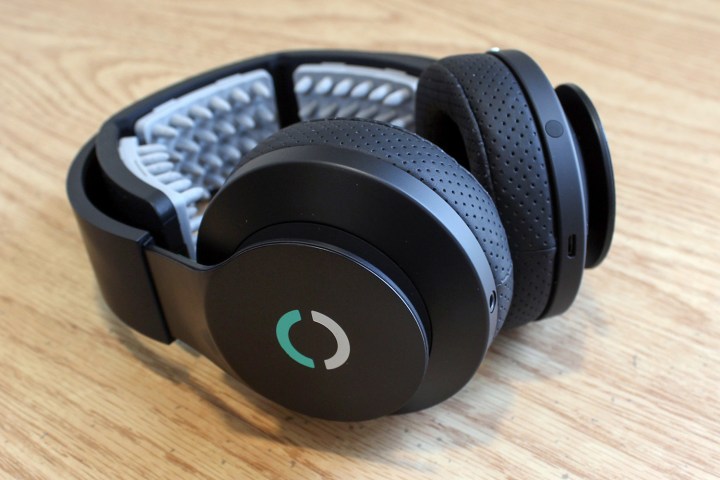Halo Neuroscience recently released its brain-training Halo Sport headphones to the consumer market — meaning for just $749, anyone can zap their neurons to improve their athleticism.
These over-the-ear headphones supposedly deliver tiny electrical impulses directly to the motor cortex, the area of your brain that controls body movement, putting those brain cells in a state of hyperplasticity; basically, it’ll make your brain temporarily more receptive to learning physical movement. This may sound like science-fiction, but the technology backing up these claims is grounded in actual research and real-world trials. Halo Neuroscience cites multiple studies and trials asserting that groups training while using the Halo Sport showed measurable improvement in strength, reaction times, and precision of movements versus control groups who trained without.
Clearly, we had to try this out for ourselves to see just how they work.
Depending on the amplitude you choose it can feel very mild or sting quite a bit.
The headphones are built from a combination of flexible metal and plastic that feels heavy-duty yet lightweight. They are pre-installed with 3.5-inch open leatherette ear cups, which provide a soft cushion while still allowing sound to pass-through if you need to pay attention to your surroundings, when biking or jogging for instance. You’ll also receive a pair of closed ear cups that you can swap in for better sound isolation. The headphones charge via microUSB and should last about eight 20-minute neuropriming sessions before needing to be charged.
The headphones do play music too, and you can plug them into any audio device using the included flat audio cable with in-line mic. You won’t be able to listen to music wirelessly, however, since the built-in Bluetooth connection is used exclusively for pairing the neuroprimers to the Halo Sport app on your smartphone or mobile device. As headphones, the audio quality is fair, which you’d hope for given its price. The sound is relatively clear with bright trebles, but mid-ranges are somewhat subdued and the bass isn’t particularly strong. The closed ear cups improve the balance somewhat, but the Halo Sport headphones can still sound a bit muffled.
Acoustic performance aside, the real reason you’re considering buying these is for their brain-boosting ability, and you won’t need to listen to music for that benefit. The Halo Sport app that controls the headphones is user-friendly and simple. It guides you through installation of the neuroprimers and lets you know when you have proper skin contact to deliver those brain-zapping electrical impulses. If the app shows poor contact with the primers, you can wiggle the headband until the nibs are touching your scalp or spritz the primers with a little more water. Three priming modes let you focus training on the whole body or hands and fingers for dexterity, with separate modes for left and right.
It’s difficult to determine the exact impact the Halo Sport has on your outcome.
During the 20-minute neuropriming sessions, the electric pulses from the primers feel prickly right where they touch your skin. Depending on the amplitude you choose it can feel very mild or sting quite a bit. It’s not painful per se, but it does take some getting used. The higher you set the amplitude, the more you’ll feel the pinpricks, so start at 1 and work your way up to 10, if you can take it. The priming effect is supposedly the same, no matter which amplitude you choose, begging the question of what amplitude really does. Halo recommends that you do light stretching, warm ups, or the less intense part of your workout during the priming session. Afterward, the neuroplastic effect lasts for about an hour, which is when you do the more intense part of your workout or training.
So does it work? The first thing to know is that you won’t get stronger or faster just by wearing these; you still have to train hard to reach your goals. The second is that it’s difficult to determine the exact impact the Halo Sport has on your outcome, because there are a lot of elements that effect any improvements you see. We conducted our own non-scientific trials using the Halo Sport for weight training and touch-typing practice, and we saw improvement in both cases. We measured upper-body strength gains via maximum pull ups after 4 weeks of training with the Halo Sport which went from 10 to 13 by the end of the trial (don’t judge). For typing skill, one tester was able to improve speed from 40 words per minute to 50 wpm and improve overall accuracy by double digits over the course of 3 weeks.

While the training and practice itself likely caused much of the gains, the speed and degree to which those skills were improved exceeded our initial expectations. During the training sessions, users noticed a better ability to focus and repeat movements more precisely with ease. Placebo effect or not, the experience was persuasive. While these aren’t Bose-quality headphones, their potential for athletic enhancement puts them in another category altogether.






